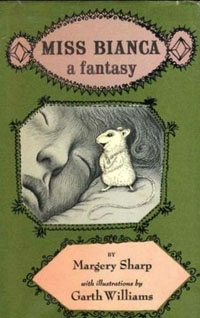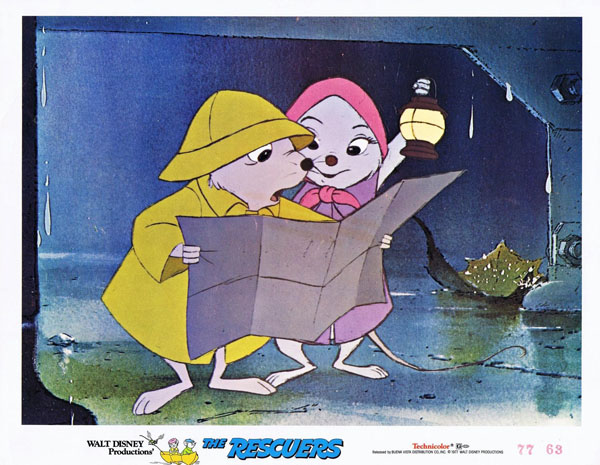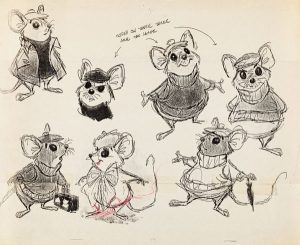 Suspended Animation #372
Suspended Animation #372
For many Disney animation fans, The Rescuers (1977) is considered a neglected favorite that receives little attention, affection and documentation.
It is actually one of the darker (including the color palette), more melancholy Disney animated features and focuses primarily on the strong female characters like Miss Bianca, Madame Medusa, Penny and Ellie Mae with the male characters being well-intentioned bumblers for the most part.
Certainly after The Aristocats (1970) and Robin Hood (1973), it definitely re-established that the Disney Studio could produce quality animation, especially since it was the last film where the fabled Nine Old Men worked on it to train a new generation of animators including Don Bluth, Glen Keane, John Musker, Ron Clements, Andreas Deja and so many others.
However, like most Disney animated features, the story went through many years of convoluted development, constantly changing and evolving.
The film is loosely based on the books The Rescuers and Miss Bianca by Margery Sharp that were just two in a nine book series about the characters that she wrote.
The books had been optioned by Walt Disney himself who began development of an animated feature in 1962. Using the storyline from Miss Bianca the story would have involved the protagonists rescuing a Norwegian human poet from a gloomy, vaguely Eastern European prison where he had been unfairly imprisoned.
 The story was changed so that the mice helped save a poet from a Cuban prison and escaped back to the U.S. under machine gun fire in an exciting boat chase in the Bahamas during a hurricane.
The story was changed so that the mice helped save a poet from a Cuban prison and escaped back to the U.S. under machine gun fire in an exciting boat chase in the Bahamas during a hurricane.
Walt was uncomfortable with the political implications in these versions. Storyman Burny Mattinson recalled, “Walt looked at it and said, ‘Geez, it’s too dark’. So the whole thing was shelved.”
Director Wolfgang Reitherman remembered that a few years after Walt’s death, the studio came up with another approach. “We had a premise where a penguin came up from the South Pole and was dumped in the zoo. In the zoo, he met a performing bear named Willie.
“The penguin conned the bear into escaping and going with him down to the South Pole where the penguin had an old wreck that he used as a showplace. He charged all the penguins to come in and see the show.
“The bear was unhappy with being forced to perform and he sent a message in a bottle that the mice found. They were going to come down and try to rescue the bear.”
 Animators Frank Thomas and Ollie Johnston once said they didn’t want to “Draw all those white-and-black penguins especially against a stark Antarctic background.”
Animators Frank Thomas and Ollie Johnston once said they didn’t want to “Draw all those white-and-black penguins especially against a stark Antarctic background.”
Mattinson said, “Our problem was that the penguin wasn’t formidable or evil enough for the audience to believe he would dominate the big bear. We struggled with that for a year or so. We changed the locale to somewhere in America and it was now a regular zoo and we tried to come up with something with the bear in the zoo and needing to be rescued but that didn’t work either.”
Storyman Vance Gerry said that Reitherman finally complained, “I just want something like a kidnap like the Dalmatians were kidnapped. That’s a simple story. That’s what I want, a simple story’. He was frustrated and couldn’t stand all the changes.”
During a lecture at California Institute of the Arts, Reitherman told the audience, “So we went to another (Rescuers) book. In this other book, there’s an old lady who was a very horrible old lady and she had this little girl and these mice rescued the little girl.” That character was the Diamond Duchess from Miss Bianca.
The bear from the South Pole version was retained and renamed “Louie” because his voice was to be performed by Louis Prima who had done King Louie in The Jungle Book (1967). Comedian Redd Foxx would have voiced a lion character. The bear would have been Bernard and Bianca’s connection to Penny.
Gerry said, “We developed the sequence where, while the two mice are searching for clues as to where Penny has been taken, they come across this bear who she had been friends with beause the orphange where Penny lived was near the zoo.”

In the novels, Bernard and Bianca were unmarried but the Disney storymen thought that since they were detectives that perhaps they should be married like famed husband-and-wife sleuths Nick and Nora Charles from The Thin Man franchise. Reitherman told author Bob Thomas, “When the mice started developing, they were married, husband-and-wife detectives….a skilled team.”
 However, that concept presented a story problem because since they knew each other so well and had worked successfully many times in the past, there were no problems, no conflict or potential for growth.
However, that concept presented a story problem because since they knew each other so well and had worked successfully many times in the past, there were no problems, no conflict or potential for growth.
So it was decided to make them amateurs who were generally unfamiliar with each other. Being novices, they had to work harder and the audience rooted for them to succeed, especially for Bernard to prove himself to Bianca.
Since there was a need for a stronger villian, character designer Ken Anderson did a series of sketches of Cruella De Vil, now wearing alligator inspired clothing. He felt that audiences loved the character and that she was an experienced kidnapper.
However, others felt it shouldn’t be a sequel and audiences would expect to see the Dalmatians so another cocktail-party sophisticated character who was vain, had a temper, was avaricous and obssessed was developed.
 Lead animator Milt Kahl did some sketches based on the vocal performance of actress Geraldine Page. Mattinson said, “Milt loved Geraldine Page. He got such a kick out of her and he started doing these drawings of her and I think everybody was just knocked out by her performance and by what Milt was drawing.”
Lead animator Milt Kahl did some sketches based on the vocal performance of actress Geraldine Page. Mattinson said, “Milt loved Geraldine Page. He got such a kick out of her and he started doing these drawings of her and I think everybody was just knocked out by her performance and by what Milt was drawing.”
Page was such a professional that she nailed the script in just one take. Kahl based the design of the character on his wife, Phyllis Bounds who he married in 1968 and divorced January 1978.
Kahl had a cruel, fiery temper and was highly competitive. When Bounds took up tap dancing and piano, he took them up as well and worked hard to be better than she was. Bounds was a strong woman, but got tired of being his wife especially when he became critical of her drinking.
Kahl later claimed that his favorite character to animate was the villainous Madame Medusa in The Rescuers (1977) because he based much of her flamboyance and “aging sexpot attitude” on his wife. He ended up doing almost all the animation for the character himself.
Animator Jane Baer, who knew them both told historian John Canemaker, “Phyllis wore boots. Medusa wore the same boots. In that scene where (Medusa’s) pulling off the eyelashes, I said, ‘That’s Phyllis!’ You just knew.”
However, Kahl did small tributes to Cruella including Medusa’s wild driving in a convertible.

Other changes occurred as well. The swamp critters were originally supposed to be members of the Rescue Aid Society who spent their time marching and drilling instead of just local residents who wanted to help. Their leader was a singing bullfrog to be voiced by Phil Harris who was later cut from the film.
Scenes of young rescue Aid Society mouse scouts working in the Society’s headquarters were reduced to a single scout blowing a fanfare.
Madame Medusa’s hideout was originally going to be a pirate fortress and later a fashionable Art Deco mansion. Gerry said, “I can remember drawing it myself and I thought I was ever so clever.”
Roy Wilson sketched an old riverboat and Ken Anderson liked it so much that he refined it as Medusa’s lair.
After four years of production, Mattinson remembered Reitherman coming to him and saying, “How come after four years this story’s so simple? Why didn’t we think of it before?”


 Jim Korkis is an internationally respected animation historian who in recent years has devoted his attention to the many worlds of Disney. He was a columnist for a variety of animation magazines. With his former writing partner, John Cawley, he authored several animation related books including The Encyclopedia of Cartoon Superstars, How to Create Animation, Cartoon Confidential and Get Animated’s Animation Art Buyer’s Guide. He taught animation classes at the Disney Institute in Florida as well as instructing classes on acting and animation history for Disney Feature Animation: Florida.
Jim Korkis is an internationally respected animation historian who in recent years has devoted his attention to the many worlds of Disney. He was a columnist for a variety of animation magazines. With his former writing partner, John Cawley, he authored several animation related books including The Encyclopedia of Cartoon Superstars, How to Create Animation, Cartoon Confidential and Get Animated’s Animation Art Buyer’s Guide. He taught animation classes at the Disney Institute in Florida as well as instructing classes on acting and animation history for Disney Feature Animation: Florida.




















































I never read the original Margery Sharp novel, but from your description it sounds as though it may have been inspired by the Norwegian poet Arnulf Overland, who was active in the Resistance during the Nazi occupation of his country and spent four years imprisoned in a German concentration camp. This is in stark contrast to Norway’s most celebrated living writer at the time, Nobel Prize winner Knut Hamsun, a vehemently anti-British supporter of Hitler who was charged with treason after the war but never tried because of his advanced age. Hamsun is still recognised as an important literary figure in Norway, but Overland is a national hero.
On a side note, the Margery Sharp books of the Rescuers series are worth reading in and of themselves. In many ways, Miss Bianca and Bernard are uniquely different in the books from their characters in the film…although some of the later books that were written after the film’s release appear to bear some influence from the Disney version. For the most part, they are consistent from book to book. Margery writes in a style that is engaging for children yet sophisticated enough to amuse adults. Some of her plot twists are ingenious! Overall, however, the books have to be appreciated separately from the two Disney films.
The Disney “Rescuers” pushes the envelope in new ways. For one thing, setting plays a major role in every scene, and this includes a wide variety of settings, from NYC to the Bayous and several places in between. Also I don’t recall any other Disney animated film that delves into the logistics of travel to this degree. We follow every leg of the journey, first of the bottle with the note as it wends its way to the Rescue Aid Society, in a series of beautifully-rendered still drawings over the opening credits, and later in the efforts of Bernard and Miss Bianca as they embark on their quest to locate and rescue Penny. And the voices of Bob Newhart and Eva Gabor, both at the time recognizable from television lend a charm to the depiction of the characters that is virtually unbeatable. Lastly, the songs have a spiritual dimension unusual for a Disney film, particularly the poignant “Someone’s Waiting for You” and the encouraging “Tomorrow is Another Day.”
The Rescuers has everything you can hope for in a great Disney film. Suspense, intrigue, sentimentality, and romance all perfectly balanced. I always considered this one a return to the solid storytelling of the greater Disney films, especially 101 Dalmatians.
I’ve wondered what led the studio decided to choose this film to do a sequel to years later. (Also an excellent and underrated film).
>I’ve wondered what led the studio decided to choose this film to do a sequel to years later. (Also an excellent and underrated film).
The first film made Disney a lot of money. At a time when they desperately needed to stay afloat, not a surprise they returned to what worked.
>By 1984, The Rescuers had become one of Disney’s most successful recent animated films, earning $41 million in worldwide box office rentals.
As an old time radio fan, my heart is also warmed by Jim Jordan’s vocal appearance as Orville the albatross. Beautifully written, articulated and animated. Jordan’s Fibber McGee character remains one of my personal favorites of 20th century popular culture, and Orville was a fitting tribute to that.
Also loved how John Candy’s Wilbur then acknowledges Orville in the “Down Under” sequel.
Also love the visual tribute to Ollie Johnston in Penny’s cat Rufus. I wonder whose idea that was, and who animated it.
“love the visual tribute to Ollie Johnston in Penny’s cat Rufus. I wonder whose idea that was, and who animated it.”
Ollie animated most (if not all ?) of the scenes of his self-caricature Rufus.
If “The Rescuers” is “neglected,” it’s because young viewers see 2D animation as, at best, a quaint antiquity. Imagine drawing by hand–how primitive! Like the annual ritual TV screenings of “The Wizard of Oz” of decades past, it’s hard to convey what a big deal a new Disney animated feature used to be back in the days when they came out (with heavy fanfare) one every four years or so instead of cranked out two or three a year like today. “The Rescuers” was the last of that tradition. It was also a first in that different colors of toner were used, giving the characters a cleaner look than the heavy black outlines (with visible construction lines) of the Xerography era.
There’s a YouTube clip someone made cleverly editing footage of Madame Medusa and Cruella so that they appear to be yelling at each other on the phone. So “The Rescuers” hasn’t been completely forgotten. Actually, its one major weakness was the little girl being too cute (clearly the Don Bluth influence).
Here’s that clip: https://www.youtube.com/watch?v=4RAgYiQtUo4
I will never not love The Rescuers. Proper, with actual effort please, Blu-ray restoration when?
At this point this is asking for too much, but could a potential european release put various nordic dubs on there?
Disregard my un-researched comment, Rescuers Bluray WAS remastered properly, not like the Sword in the Stone and Robin Hood fiascos.